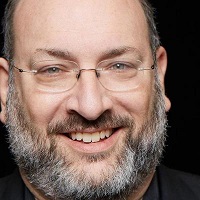 By David Harlow, JD MPH, Principal, The Harlow Group LLC
By David Harlow, JD MPH, Principal, The Harlow Group LLC
Twitter: @healthblawg
Host: Harlow on Healthcare
Hashtag: #HarlowOnHC
Ed Marx is the CIO of the Cleveland Clinic. He’s a Fellow of HIMSS and CHIME, and has been recognized by the two organizations as the CIO of the year. He partners with Clinic leaders, and his responsibilities include development and execution of strategic planning and governance, driving optimal resource utilization, team development and ensuring organizational support. He works to develop leaders and leverage digital healthcare technologies to enable superior business and clinical outcomes. You should check out his blog at HIStalk, called CIO Unplugged, and you should follow him on Twitter: @marxtango.
My excuse for speaking with Ed was HIMSS’ recent recognition of the Cleveland Clinic with a Davies Award (read all about it at the link). Three projects — a heart failure checklist, cardiac codes reduction (the “VitalScout” project) and hypertension improvement — led to the Enterprise Davies Award. Beyond discussing what led to this recent accolade — for which Ed credits the team, also noting that most of the work was done before his arrival at Cleveland Clinic — it is always interesting to hear what he has to say about health IT.
We kicked off our chat with Ed noting that while in the digital age we can be engaged in rapid innovation and improvement, there is no particular endpoint. Nirvana is always around the corner. There’s always another summit. He reminds us that we need to keep our work in perspective: Our children and grandchildren will look back at it and think it’s pretty primitive.
Ed’s take on the Cleveland Clinic and recognition like the Davies Award is that the institutional leadership and culture value passion, value the health IT folks working closely with front line clinical staff, value “failing forward,” as long as the failures don’t involve patient care. These values liberate thinking and allow teams to succeed.
This perspective reinforces a key theme of healthcare innovation and health IT improvement: the technical problems are often easier to solve than the cultural and political problems. Ed is focused on creating an environment in which passionate professionals can do good. He noted the VitalScout project was initiated by an employee who was passionate about an issue, saw an opportunity, brought it to the attention of leadership — and it is now saving lives, with a significant reduction in cardiac codes.
Ed brings his athlete’s mindset to work with him as well. As a duathlete on TeamUSA he’s been seeing another side of the power of data analytics. His cycling coach used a plethora of measurements and predictive analytics to adjust his training and got him to make a real mindshift: not focusing on speed (MPH) — the output — but instead on the stats that together yield the speed: cadence, wattage, heart rate. It’s all about focusing on the building blocks, rather than the ultimate goal, in order to better be able to do the work to reach that goal.
The IT organization exists to serve the clinical organization, and aside from making sure the trains run on time, a whole variety of interesting initiatives draw the IT teams in. One recent example is the Clinic’s collaboration with Oscar (the health insurance company). Oscar and the Clinic collaborated and created an interoperability solution that yielded better analytics leading to improved ability of clinicians to manage patients and improved patient engagement. (Part of what allows Ed and his team to help by being responsive is embedding IT business partners within the clinical institutes.)
We talked about shortening the “bench to bedside” time. I noted that the old saw would have that it takes 17 years to make that journey. Ed highlighted one Clinic example where this was reduced to two or three years, and another where a physician was able to leverage technology to address a problem and apply a solution within about a year.
In order to bring focus to the IT work across the institution, Ed and his team have three key priorities: Align, Optimize & Transform.
First: The goal is to align IT and clinical teams on the front end.
Second: Optimize means: improve governance, and achieve high reliability. Ed wants his team to be good stewards, to increase value by lowering cost and increase service.
Third: The IT function and infrastructure is transforming from legacy IT to a digital platform. The key questions include: Do you have a robust enough network to enable all the things that everyone wants to do? Ed notes the need to provide the infrastructure for IoT, mobile devices and secure caregiver communications. Everything doesn’t need to be on the same platform but everything needs to interoperate, communicate, share data.
Guiding progress on these, Ed articulated three “uber” priorities: security, deep analytics and using an agile approach. Ed is completely restructuring IT at Cleveland Clinic (beyond development and project management) based on agile principles. As he put it, it is “changing completely the way in which we work to be more effective, to become more efficient, to bring back some joy in work.”
This article was originally published on HealthBlawg and is republished here with permission.
